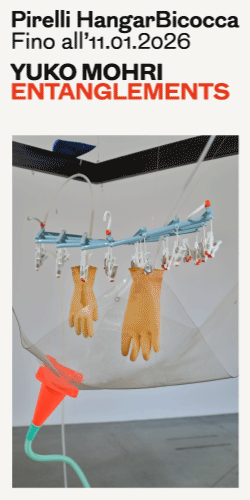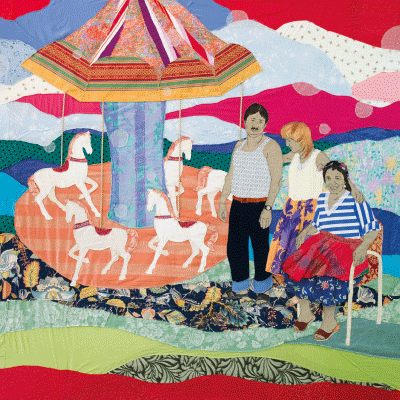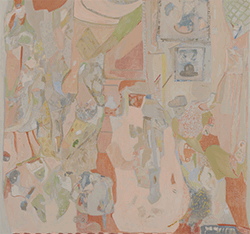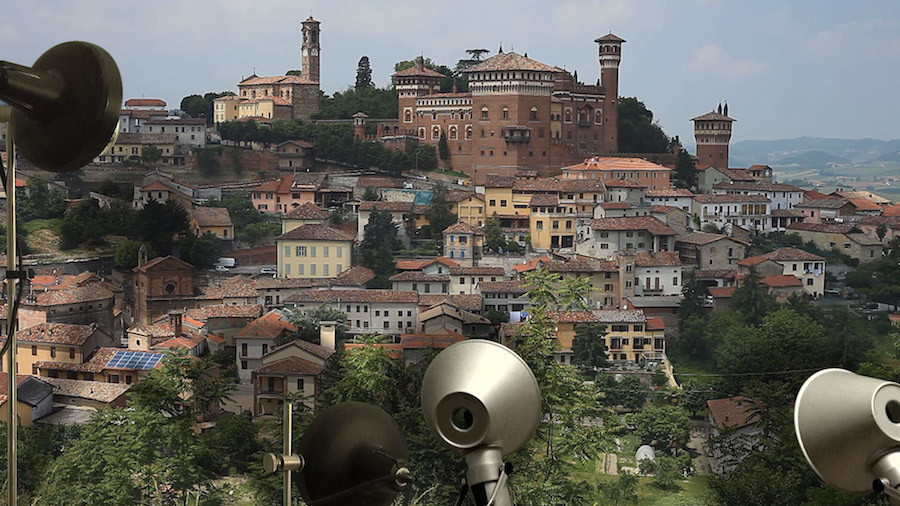
English version below.
Proseguono gli ‘incursioni’ di ATPdiary nel festival Lo Schermo dell’Arte (fino al 22 novembre). Dopo le interviste alla direttrice Silvia Lucchesi e al curatore Leonardo Bigazzi, ATPdiary ha intervistato Antje Ehmann, collaboratrice e moglie di Harun Farocki, che presenterà Parallel I – IV (2014) e Lisa Immordino Vreeland, regista statunitense, che presenterà il biopic Peggy Guggenheim: Art Addict (2015). Seguono le due brevi interviste fatte da Martina Odorici al collettivo Flatform, che presenterà il corto Quantum. (2015) e ad Angelo A. L üdin, che presenterà il film Thomas Hirschhorn – Gramsci Monument (2015).
Giovedi 19 novembre, alle ore 21 presso il Cinema Odeon, verrà presentato il cortometraggio Quantum. (2015), del collettivo Flatform
Il collettivo, nato nel 2007 da artisti e videomaker con sede a Milano e Berlino, si occupa da sempre di accostare cinema e arte, attraverso la produzione di video e video-installazioni in cui la post-produzione gioca un ruolo importante. In Quantum. una ripresa fissa di un paese collinare italiano e i suoni delle attività al suo interno, sganciati tra loro e accompagnati da un’aria pucciniana, presentano allo spettatore un momento straniante generato da una quotidianità prosaica.
ATP: Il vostro cortometraggio è una ripresa fissa di un paese italiano di collina, visto da lontano. Dal punto di osservazione non si riesce a cogliere cosa succede nel paese, ma si sentono i suoni delle attività che al suo interno si svolgono. Cosa suggerisce questo scollamento suono/immagine?
FF: Nei nostri lavori, quando utilizziamo la non corrispondenza tra visione e suono è perché questa modalità risulta per noi uno dei possibili mezzi per adeguare modelli narrativi quali sfondo, primo piano, messa a fuoco selettiva, controcampo etc, alla nostra idea di visione totale, assoluta ma circostanziata, del tutto. Per tutto, intendiamo riferirci più alla somma di ogni singolo elemento costitutivo che non a una totalità preesistente. Va anche detto che i suoni sono per noi una componente estremamente importante all’interno del processo di scambio, composto da registrazione e da ri-creazione, con il paesaggio, e accentuare la non reciprocità tra vista e udito, ci permette di aggiungere alla somiglianza la partecipazione. Con questa modalità, infatti, integriamo il carattere inevitabilmente mimetico innescato dalla visione del paesaggio, con quello prettamente metessico dell’ascolto del paesaggio. La non corrispondenza tra visione e suono può avere per noi carattere temporale, nel senso che tra i suoni e le immagini cui i suoni si riferiscono, attuiamo uno slittamento temporale che ci permette di rendere duttile l’idea su quale sia il presente. Altre volte creiamo uno sfasamento audio-visivo che ha invece a che fare con la spazialità: diamo a un avvenimento in lontananza il suono in primo piano; lo spazio dell’immagine per quanto grande si restringe, e i singoli elementi non appaiono vicini o lontani ma grandi o piccoli.
Scorte in lontananza, le azioni in Quantum. vengono dall’oscurità, si intravedono o determinano nella luce. Buio e luce provocano effetti analoghi e solo il suono e il tempo variato permettono di sentire vicino e presente quello che avviene in lontananza e che la distanza rende ridotto nelle dimensioni e impercettibile nella comprensione. In Quantum., così come nelle teorie considerate obsolete di Athanasius Kircher, il suono è l’imitazione della luce.
ATP: Tutto ciò che viene ripreso sembra una miniatura; questo modello ha un significato particolare?
FF: Nella costruzione di questo video, di volta in volta abbiamo opposto e integrato la riduzione di scala e la illuminazione. E si sa che “miniatura” è un concetto che, nella sua storia, attraversa sia il colore come luce che la dimensione ridotta degli oggetti e delle forme. Inoltre, in questo processo di miniaturizzazione, in Quantum. abbiamo inteso e trattato l’oggetto delle nostre riprese, ovvero il paese, come un vero e proprio plastico architettonico da studio.
ATP: C’è un riferimento politico al nostro paese, anche e soprattutto a livello culturale?
FF: Ogni mutamento di paradigma ha per sua natura carattere politico. In Quantum., e nel nostro lavoro in generale, produciamo questo mutamento sottoponendo le leggi naturali e fisiche a uno stress che le allontana dal loro perimetro convenzionale. Nel nostro statement diciamo che Quantum. documenta la possibile non esistenza di alcune leggi considerate naturali. In questo video il processo che adegua la luce e il buio al degradare del giorno verso la notte, e viceversa, non esiste. La rotazione della Terra intorno al suo asse non esiste. Perciò, anche le variazioni della luce che convenzionalmente determinano il calare del giorno e della notte non esistono. Le immagini, come le luci, non sfumano, non si confondono e non si fondono coi loro opposti. Gli opposti restano indipendenti dai loro inversi, entrambi vincolati da una natura immutabile. Nel nostro lavoro vi sono due punti fermi che sono il punto di partenza e il punto di arrivo: entrambi coincidono con la realtà. E’ nel mentre che operiamo i nostri slittamenti di senso, ridefiniamo le corrispondenze di possibilità e impossibilità e ricomponiamo in un tutt’uno verosimile elementi la cui coesistenza non sarebbe altrimenti plausibile. Intendiamo dire che lavoriamo sulla realtà con un processo dissociativo che si apre a nuove possibili associazioni le quali ricompongono gli svariati elementi in un’altra realtà. Questa attività prefigura uno stato di eccezione, intendendo, con questo sintagma mutuato dalla terminologia bio-politica, una sorta di sospensione dell’esperienza ordinaria che isola la vita di diversi punti di un insieme sottraendoli al rapporto normale con il mondo e reinserendoli in nuovi rapporti con esso e con le cose. E anche se in maniera non palese e diretta, questo è un gesto che interviene anche sul livello bio-politico, poiché nell’atto di riassociare, ovvero di riscrivere c’è anche il tentativo di liberare la vita da qualcosa che la imprigiona e la relega nella sfera del puro sentimentalismo. Infine, riteniamo che questo sia veramente e sottilmente politico del nostro lavoro: non usare termini quali illusorio, ottico oppure percettivo quando parliamo di una costruzione altrimenti impensabile della realtà. Il lavoro di Flatform non va dalla realtà verso l’astrazione e non evoca dimensioni immaginarie.
ATP: L’aria Nessun Dorma della Turandot di Puccini, senza la voce dei cantanti, che accompagna il video ha una sua valenza, immagino. Quale?
FF: Sottraendo il cantato e la sua melodia, la struttura musicale del Nessun dorma appare di grande modernità nella sua progressione armonica e nella sua ripetitiva insistenza. L’aria pucciniana appare all’inizio come un jingle in loop, non è immediatamente riconoscibile ed è, con l’utilizzo di due sole battute, lirico, tecnico, rigoroso. Abbiamo scelto di sottrarre il canto per dare al suo testo il carattere di voice-over testuale nella composizione dell’immagine. Il testo dell’aria, traslitterato, ha una profonda attinenza con il senso generale di Quantum.. Nel canto, la questione è incentrata sulla scoperta, entro l’alba, del nome del personaggio pucciniano; nel video, l’alba è la cognizione e il nome la sua nominazione. Ma l’alba non svela alcun nome perché, come per il personaggio pucciniano, la verità si nomina da sola, si disvela da sé medesima.

Giovedi 19 novembre, alle ore 22 presso il Cinema Odeon, Angelo A. Lüdin presenterà, per la prima volta in Italia, il suo ultimo film, Thomas Hirschhorn – Gramsci Monument (2015).
Da sempre interessato alle personalità forti e complesse degli artisti (di arti visive, musica, letteratura, teatro), L ü din indaga in questo film, in modo concerto e lucido, senza sentimentalismi, il processo creativo ed esecutivo di una grande opera, cercando anche di evidenziarne le falle, le crepe, i piccoli fallimenti. Concentrandosi non soltanto sull’artista e la sua psicologia, ma molto anche su chi è “costretto” a partecipare all’allestimento e alla fruizione di un’opera d’arte pubblica, vengono svelati meccanismi di interazione e piccole crisi di fiducia che dimostrano la non facile convivenza di arte e quotidianità in una comunità complessa.
ATP: Come è nato questo film?
AL: Conosco il lavoro di Thomas Hirschhorn dagli anni ’90. L’incontro con il lavoro di Hirschhorn Crystal of Resistance al padiglione svizzero della Biennale di Venezia 2011 è stato l’innesco per il mio film Thomas Hirschhorn – Gramsci Monument. L’installazione energetica ed eccessiva di Hirschhorn ha stimolato il mio interesse verso la sua arte e la sua affermazione di assolutezza, e mi ha spinto a conoscerlo meglio. Nello stesso tempo l’installazione ha fatto nascere in me uno strano sentimento. Quel sentimento mi ha dato l’opportunità di fare questo film.
ATP: Qual’era l’intento di Thomas Hischhorn in questo progetto? E perché ha scelto di lavorare su una figura come quella di Antonio Gramsci?
AL: Questa è una cosa che dovete chiedere a lui.
ATP: Qual’è il focus del suo film? L’artista, l’opera d’arte, il suo ambiente…?
AL: La mia intenzione nello sviluppare il film era quella di mostrare le interazioni tra chi lavorava, il progetto di housing sociale Forest House e l’artista. In più, volevo far emergere gli incontri tra visitatori culturali e residenti del quartiere durante l’operazione di installazione. E, ovviamente, ero interessato a quello che la filosofia di Antonio Gramsci avrebbe scatenato nei residenti nel loro confronto quotidiano con la transitorietà del Gramsci Monument.
ATP: Il suo film è un documentario o piuttosto una possibile interpretazione del lavoro di Hirschhorn?
AL: Come regista di documentari non puoi fare altro che mostrare il tuo punto di vista e il tuo atteggiamento verso il tema che stai trattando. Per me è stato chiaro che non volevo nessun commento da esperti o curatori o direttori di museo, nel film. Volevo dare voce alla gente del Bronx, che nella vita devono far fronte a problemi sociali, disoccupazione, spaccio di droga, criminalità e confrontarsi con l’assenza delle strutture pubbliche. Il risultato dell’intervento artistico alla Forest House ha relativizzato il mio iniziale scetticismo verso il progetto Gramsci. Quindi sono convinto che il film Thomas Hirschhorn – Gramsci Monument sia una nuova analisi del pubblico del lavoro del monopolizzante, ribelle artista svizzero contemporaneo.
From the 18th to the 22nd of November, 2015, Florence will host the eighth edition of Lo Schermo dell’Arte Film Festival.
After the introduction and the interviews of the director of the festival Silvia Lucchesi, the curator of the section VISIO Leonardo Bigazzi and the director of Palazzo Strozzi Arturo Galansino, four brief interviews to some of the participating artists and directors. Here the interviews with the collective Flatform, that will present the short film Quantum. (2015) and with Angelo A. L üdin, author of Thomas Hirschhorn – Gramsci Monument (2015).
Thursday the 19th of November, at 9 pm, at the Cinema Odeon, the short movie Quantum. (2015), by the collective Flatform, will be presented.
The collective was born in 2007 from a group of artists and video makers, and has its seats in Milan and Berlin. Its activity has always been focused on the possibility to combine cinema and art, trough the production of videos and video-installations in which post-production plays a very important role. In Quantum. a static shot of an Italian village in the hills and the sounds of the activities taking place there, divided and out of sync, accompanied by a sound piece of an opera by Giacomo Puccini, present to the viewer a strange moment coming from a mundane daily life.
ATP: Your short film is a static shot of an Italian village on the hills, seen from a distance. From the observation point is not possible to see exactly what is happening in the village, but it’s possible to hear the sounds of the activities that are taking place there. What does this detachment of sound/image suggest?
FF: In our works, when we are not using the correspondence between image and sound it’s because this is a way for us to adequate narrative models as background, foreground, selective focusing, reverse shot etc., to our idea of total vision, absolute but circumstantial, of the whole. For “whole” we mean more the sum of every single constitutive element then a pre-existing totality. It has to be said that sounds are for us an extremely important component of an exchange process, composed by registration and recreation, with the landscape, and emphasizing the non-reciprocity between vision and hearing permits us to put together similarity and participation. In this way, in fact, we integrate the unavoidably mimetic character triggered by landscape vision, with the exclusively active action of hearing the landscape. The non-correspondency between sound and vision can have a temporal character, meaning that between sounds and images to which sound are referring, we act a slipping of time that allows us to make the idea of what the present is more flexible. Some other times we create an audio-video out of phase that is more referred to space: we assign to an activity that is taking place far away the sound of something happening in the foreground; the space of the image, also if it’s very big, tends to shrink, and the single elements do not appear to be close or far way but big or small. Seen from a distance, the actions in Quantum. are coming from the darkness, glimp or are seen more clearly in the light. Darkness and light provoke similar effects, and only the sound and different time permit to hear as close or far what is happening in the distance and the distance makes small regarding dimensions and indiscernible for understanding. In Quantum., as in the theories of Athanasius Kircher, now considered obsolete, sound is the imitation of light.
ATP: Everything seems to be a miniature; does this approach have a particular meaning?
FF: In the construction of this video, each time we opposed and integrated scale reduction and lighting. And it is known that “miniature” is a concept that, in its history, experiences both colour as light and reduced dimensions of the objects and shapes. Moreover, in this process of miniaturizing, in Quantum. we meant and handled the object of our shots, the village, as a real architectonic studio scale model.
ATP: Is there a political link to Italy, most of all to its cultural situation?
FF: Every paradigm change is in its nature political. In Quantum., and in our work in general, we produce this change submitting natural and physical laws to a stress that distance them from their conventional outer limit. In our statement we declare that Quantum. supports the possible non-existence of some laws considered as natural. In this video the process that adjusts light and darkness to the shift from day to night, and vice versa, does not exists. The revolution of the Earth around its axis do not exists. So, also lights variations, that conventionally determine the set of the day and night do not exist. The images, as the lights, do not blur, do not mix up and do not blend into their opposites. The opposites stay independent from their inverses, both tied to an unalterable nature. In our work there are two pivotal points that are our starting point and our arrival point: both correspond to reality. It’s in the meantime that we work for our sense shifts, that we redefine the correspondences and the possibilities and impossibilities and we recompose in a credible whole elements which coexistence would not otherwise be plausible. We mean that we work on the reality with a dissociative process that opens up to new possible associations that recreate their diverse elements in another reality. This activity prefigures a state of exception, meaning, with this verb phrase borrowed from bio-political terminology, a sort of suspension of ordinary experience that isolates life of different points of a whole removing them from the normal relationship with the world and putting them anew in different relations with it. And, even if not in a manifest and direct way, this is also a gesture that intervenes on the bio-political level, because in the act of re-associating, that means re-writing, there is also the try to free life from something that locks it up and banishes it in the sphere of pure sentimentalism. In the end, we think that this is really and subtly political of our work: not using terms like deceptive, optic or perceptive when we talk about an otherwise impossible construction of the reality. The work of Flatform does not go from reality to abstraction and does not evoke imaginary dimensions.
ATP: I think that the aria Nessun Dorma from Turandot by Giacomo Puccini (without the voices of the singer) that accompanies the video has its own importance. Which one?
FF: Taking away the sung part and its melody, the musical structure of the Nessun Dorma appears really modern in its harmonic progression and its repetitive insistence. The aria by Puccini sounds, at the beginning, like a loop jingle, it is not immediately recognizable and it is, with the use of only two bars, lyrical, technical, rigorous. We decided to remove the voice to give to its text the textual character of voice-over in the composition of the image. The aria text, transliterated, has a deep relevance for the general sense of Quantum. In the singing, the point is focused on the discovery, before the sunrise, of the name of the character; in the video, the sunrise is the awareness and the name its name-giving. But the sunrise does not unveil any name because, as the character from Puccini’s story, the truth name herself, unveils herself alone.
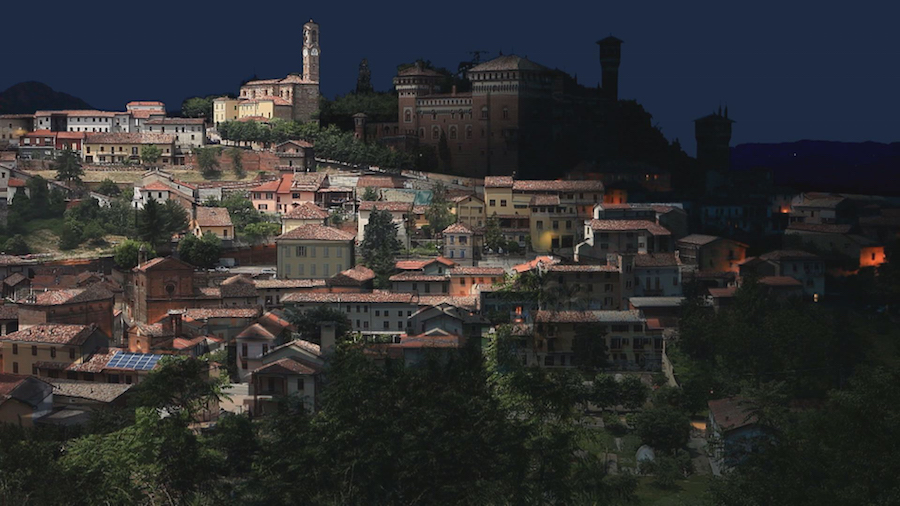
LO SCHERMO DELL’ARTE –
Thursday the 19th of November, from 10 pm, at the Cinema Odeon, Angelo A. Lüdin will present, for the first time in Italy, his last film, Thomas Hirschhorn – Gramsci Monument (2015).
L ü din has always been interested in the strong and complex personalities of artists (visual artists, musicians, writers, actors), and he analyses here, concretely and lucidly, without sentimentalisms, the creative and executive process of the birth of a big work of art, trying as well to underline its flaws, its cracks, its small failures. Concentrating not only on the person of the artist and his psychology, but very closely also on who was “forced” to take part in the set up and fruition of a work of public art, mechanisms of interaction and little confidence crisis are unveiled, demonstrating the not easy cohabitation of art and daily life in a complex community.
ATP: How did this film come to life?
AL: I know the work of Thomas Hirschhorn since the 1990’s. The encounter with Hirschhorn’s work, Crystal of Resistance at the Biennale in Swiss Pavilion in Venice (2011) was the trigger for my film Thomas Hirschhorn – Gramsci Monument. Hirschhorn’s energetic, and excessive room installation stimulated my interest to learn more about his art and about its claim to absoluteness. At the same time, this installation also triggered an ambiguous feeling in me. Such a feelings gave me the opportunity for this movie.
ATP: Which was the aim of Thomas Hischhorn with this project? And why did he choose to work on a figure such as the one of Antonio Gramsci?
AL: That is something you have to ask him.
ATP: Which is the focus of your film? The artist, the work, its environment…?
AL: My intention at developing the film was showing interactions between the employees, from the social housing project Forest Houses and the artist. In addition, I wanted to visualize encounters between cultural visitors and residents of the settlement during the operation of the installation. And of course, i was interested in what would trigger Antonio Gramsci’s philosophy with the residents in their daily confrontation with the transitory Gramsci Monument.
ATP: Is your film a documentary or rather a possible interpretation of Hirschhorn’s work?
AL: As a documentary director you always show your point of view and your attitude towards a matter. For me it was clear that I don’t want any comments by experts or by curators or museum directors in the film. I wanted to give the voice to people from the Bronx whose life is marked by social problems, unemployment, drug dealing, high crime rate and crumbling public infrastructure. The output of the art intervention at Forest Houses has relativized my initial scepticism to Gramsci project. So I am convinced that the film Thomas Hirschhorn – Gramsci Monument is a new insight to the public at the work of monopolizing, rebellious Swiss contemporary artist are.




